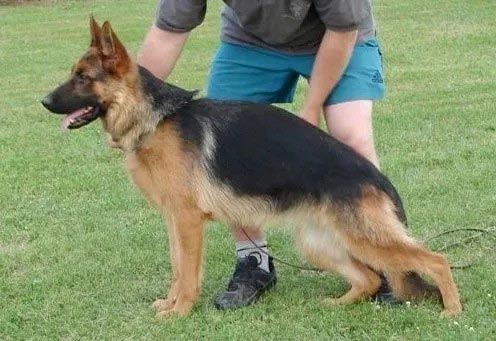By Karen Henkel-Kennedy
(puppy shown is Pepsi Wilhendorf)
As winter loosens its grip, it is time to begin training in earnest for the upcoming breed shows. Hopefully we have all had a productive winter, getting our dogs and ourselves in proper condition, and now need only a bit of last minute polish.
For showing, your dog needs to be in good physical shape. I often hear of people using treadmills and other inorganic methods to prepare dogs for a big competition. Our breed is bred to work for hours on end. The best way to develop the dog as it is meant to be is by allowing it to do what it is meant to do. Natural exercise, hiking, swimming, running, and biking with the beloved owner is the best conditioning one can provide for one’s dog.
A good rule of thumb for young dogs is steady exercise that does not harshly jar developing joints, three times a week to the point of fatigue. To clarify, swimming or walking steadily with the owner for 20 minutes at the onset, gradually increasing until the dog (and owner) is comfortable with a more strenuous program.
Our working dogs should already be in excellent physical condition from the work they do in tracking, obedience, and protection. A dog that does a long track, a rigorous obedience routine, and runs six blinds a few times a week is in good shape. Add some long walks or runs when you have the time, and your dog should be ready for showing. A two to three mile run a few weeks before showing might help the owner feel more confident. It is always helpful for the double handler to be in shape as well!
Keep in mind that the dogs in the working classes will be required to do an off-leash lap, which should not be a matter of concern if they are able to heel. Practicing a running heel will help to make this aspect of showing smoother.
Dogs over 12 months will be exposed to the sound of gunfire in the ring. A sound dog will not be affected, but if you have the opportunity to have a club member shoot a blank gun, you will know ahead of time how your dog reacts. Dogs must be held on a loose lead during this test.
Accustom your dog and yourself to the routine that is followed in every show for the individual exam. When showing the tattoo to someone make sure you secure the dog’s head. One way is to have the dog sit on your right side, take the dog’s muzzle with your left hand, and slightly turn the head toward your left, which exposes the right ear and the tattoo. Don’t allow the dog to jump on the judge or make the judge handle the dog’s head for you. Usually the examination of the mouth follows the tattoo check, show the scissors bite or front teeth, then the molars, and don’t forget those tiny P1s. When the dog is panting the tongue usually covers the P1. Work with your dog to be able to move the tongue to show the P1s. Again one way is to be in the same position as when showing the tattoo. The judge or steward must see all of the teeth in the mouth. In order to accomplish this, the handler’s head must not block the view of the person examining the teeth. If you would like to see the teeth, look before or after, and leave the exam in the ring to the officials.
When the judge or steward is checking testicles, hold the dog firmly so that his head can not swing around. This test should be effortless. It is not necessary to hold the dog so tightly he feels threatened. Simply keep him from turning around. The judge and / or ring steward appreciates you knowing what to do and being prepared for these examinations. Watch other dogs being examined, usually the judge or ring steward has a particular sequence for doing the exam.
If the show you are attending is a Sieger show and your dog is in the Working class, which means he/she already has a Schutzhund title, you will need to have him/her prepared to heel to the blind for an attack on handler, followed by a clean out, and a long grip on a different helper, again followed by a clean out with no more than three commands. It is then necessary to reattach the leash and walk your dog off of the field in a controlled manner. This test varies from country to country, but a dog that can function well to the specifications I have mentioned here will be able to pass the test anywhere, assuming she/he displays courage and good grips.
In addition to these items, feed a top quality food, groom your dog occasionally, and have fun. The more natural your dog’s environment, the healthier you both will be.
Karen Henkel-Kennedy is Assistant Training Director of Ortsgruppe Wesconn Schutzhund Club in Connecticut, where she lives with her husband Kevin Kennedy, daughters Shannon and Bridget, and son Rory. Together with her family, Karen owns and operates Wilhendorf Kennel which has been USA’s #1 breeding kennel for the past 6 years. First involved in schutzhund as a child, in NASA affiliate Wesconn SchH Club, Karen is a member of USA’s SchH3 Club, USA, member of the Breed Advisory Committee and the SV. Karen owns Lussi von Wilhendorf, USA’s 1998-99 Siegerin.
This article has been republished with the consent of the United Schutzhund Clubs of America who originally published this article in its bi-monthly magazine. For more information on Schutzhund or membership with the United Schutzhund Clubs of America please visit their website www.GermanShepherdDog.com.

